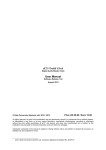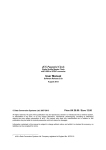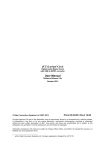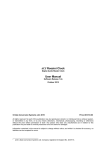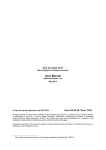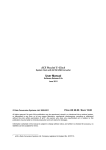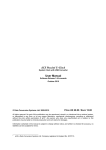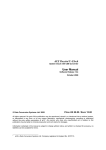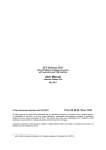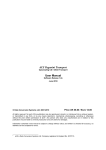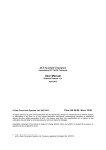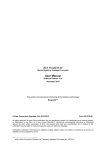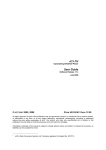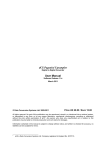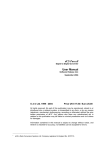Download "user manual"
Transcript
dCS Vivaldi Clock Digital Audio Master Clock User Manual Software Release 1.2x April 2015 © Data Conversion Systems Ltd. 2012 - 2015 Price UK £10.00 All rights reserved. No part of this publication may be reproduced, stored in or introduced into a retrieval system, or transmitted in any form, or by any means (electronic, mechanical, photocopying, recording or otherwise) without the prior written permission of dCS1. Any person who does any unauthorised act in relation to this publication may be liable to criminal prosecution and civil claims for damages. Information contained in this manual is subject to change without notice, and whilst it is checked for accuracy, no liabilities can be accepted for errors. 1 dCS is Data Conversion Systems Ltd. Company registered in England No. 2072115. dCS Vivaldi Clock User Manual Vivaldi Clock Manual v1_2x Software Issue 1.2x April 2015 Page 2 English version dCS Vivaldi Clock User Manual Software Issue 1.2x April 2015 Contents Using the dCS Vivaldi Clock for the first time ....................................................................................4 4 4 5 What’s in the box? Positioning the unit Safety Notice Step-by-Step Guide ...............................................................................................................................6 Preliminaries The GOLDEN RULES for using a Master Clock Connecting the system for CD/SACD playback A full Vivaldi system Using an External Reference Using sources that cannot lock to Word Clock 6 6 7 8 9 9 Front Panel ...........................................................................................................................................10 Remote Control Receiver Display Power Button Menu Button Freq1 Button Freq2 Button 10 10 11 11 11 11 Rear Panel ............................................................................................................................................12 12 12 12 13 13 Reference Input Word Clock Outputs Test interface Mains inlet Label The Menu ..............................................................................................................................................14 Using the Menu INFORMATION Menu Unit Status Version Contact Update CLOCK SETTINGS Menu Reference In Dither RS232 Mode CONFIGURATION Menu Settings Lock Save Configuration Restore Configuration Factory Reset DISPLAY SETTINGS Menu Brightness Display On/Off 15 16 16 16 16 16 17 17 17 17 18 18 18 18 18 18 18 18 Specification ........................................................................................................................................19 Maintenance and Support...................................................................................................................20 Service and Maintenance Replacing a Blown Mains Fuse Cleaning the case Limited Warranty If you need more help Software History 20 20 20 21 22 22 Index .......................................................................................................... Error! Bookmark not defined. Vivaldi Clock Manual v1_2x Page 3 English version dCS Vivaldi Clock User Manual USING THE dCS VIVALDI CLOCK Software Issue 1.2x April 2015 FOR THE FIRST TIME Congratulations on purchasing your dCS Vivaldi Clock. Before using your unit, please read this section and the Step by Step Guide. This will enable you to set the unit up quickly and safely with your hi-fi system. From time to time, dCS will release updated software on CD that you can install yourself using the Update feature. Please check our web-site occasionally to see if new Vivaldi software is available, or consult your dealer. What’s in the box? Check that the box contains the following items: • • • • • dCS Vivaldi Clock Manual and Menu / Setup Guide Power cable 2x BNC cables Spare fuses Notify your dealer as soon as possible if anything is missing or damaged. We suggest that you retain the original packaging for possible future use. If this is not possible, replacement packaging can be ordered from dCS or our distributors. Details can be found on our web site at www.dcsltd.co.uk. A dCS Premium remote control is supplied with the Vivaldi DAC. Positioning the unit For best sound quality, the units in the Vivaldi range are designed to be mounted on separate shelves of a rack, although they may be stacked directly on top of each other if this is absolutely necessary. Place each unit on a firm, vibration free base, allowing convenient connection to the other parts of your system. To prevent overheating, we recommend that you leave some free space around the unit to allow for ventilation. The unit is supplied with 4 feet fitted. If you prefer a 3-feet layout, unscrew the two back feet, remove the two black cores using a 2.5mm A/F Allen key, fit one of the cores in the middle position and replace the foot. Take care not to cross-thread the foot! With all feet screwed fully home, the unit will sit level on a flat surface. If you need to do any levelling, you can unscrew any of the feet up to 3 complete turns, to give up to 3mm (1/8”) of height adjustment. Vivaldi Clock Manual v1_2x Page 4 English version dCS Vivaldi Clock User Manual Software Issue 1.2x April 2015 Safety Notice Your dCS Vivaldi Clock contains no user serviceable parts. DO NOT attempt to open the case as there are potentially dangerous voltages present inside. In the event of the unit developing a fault, please contact your dealer in the first instance. If you decide to remove safety covers for any reason, disconnect the power cable first. To maintain protection from electric shock, the unit MUST be connected to mains earth (ground) via the power cable. Also, unearthed systems do not give the best sonic performance. Protect the product from dripping or splashing liquids. Liquid-filled objects such as vases must not be placed on the product. This product is lead-free and complies with the RoHS directive. Before connecting the power cable to the unit for the first time, please check that it has been set to the correct operating voltage for your mains supply. The unit’s voltage setting is shown on the serial number label. If this does not match your local supply voltage, DO NOT attempt to use the unit. Contact your dealer to have the unit reset. Using the unit with the wrong mains setting for your local supply may result in serious damage to the unit and will invalidate the warranty. Do not attempt to reset the voltage yourself. We do not recommend the use of mains regenerators. However, if you do wish to use a mains regenerator with variable voltage and frequency, we recommend that you set the voltage to match your local voltage and the frequency to either 50Hz or 60Hz ONLY. ! Damage caused to your Vivaldi Clock by misuse of a mains regenerator or by a malfunctioning mains regenerator is not covered by the warranty. Disposal at end-of-life - the symbol indicates that this product should not be treated as normal household waste. It should be recycled, so please take it to an approved collection facility. Vivaldi Clock Manual v1_2x Page 5 English version dCS Vivaldi Clock User Manual Software Issue 1.2x April 2015 STEP-BY-STEP GUIDE This section guides you through setting up the unit for basic operation. Preliminaries The Menu Guide sheet details the menu structure. For all of the Word Clock Outputs and the Reference Input, use 75Ω coax cables fitted with BNC plugs. Connect the power cable supplied to the power inlet on the Clock rear panel, plug the other end into a convenient power outlet. ! Please do not use an excessively heavy or inflexible power cable as this may damage the power inlet connector. The cables supplied with the unit are “commercial grade”, because most owners will have their own “audiophile grade” cables or will prefer to make their own cable choices. Set the rocker switch near the mains inlet to the I position. Press the Power button - the unit will display Vivaldi Clock. Wait about 30 seconds while the Clock configures itself. If the unit is likely to be set in an unfamiliar state, you can run the Factory Reset routine by pressing the buttons in this sequence: Menu, ►, ►, Menu, ◄, ◄, Menu. Wait a few seconds while the unit resets itself. The GOLDEN RULES for using a Master Clock 1. The source equipment MUST be locked to the Master Clock. If it is not, you will either have locking difficulties or hear occasional clicks or drop-outs and the advantages of using the Clock will be lost. Some non-dCS CD transports, satellite receivers, DAB radios and other equipment do not have a Word Clock Input and so CANNOT be locked to a Master Clock. When a computer or sound server is driving a dCS unit (USB DAC, Upsampler or U-Clock) via a true asynchronous USB or Network interface, the dCS unit controls the clocking and behaves as the source equipment. dCS USB DACs and Upsamplers can either use their internal clock or lock to a Master Clock. 2. The clock frequency MUST match the sample rate(s) used in the system. If it does not, the system cannot lock and the DAC may remain muted. Please check the manuals for the equipment used in your system. 44.1kHz Word Clock is compatible with DSD-based systems, CD systems without an upsampler running at 44.1kHz or CD systems upsampling to 88.2kS/s, 176.4kS/s or 352.8kS/s, or a computer streaming data at 44.1, 88.2 or 176.4kS/s. 48kHz Word Clock is compatible with a DVD player or DAT recorder fitted with a Word Clock Input running at 48kS/s, or upsampling to 96kS/s or 192kS/s, or a computer streaming data at 32, 48, 96 or 192kS/s. To make best use of a Master Clock, all the digital audio units in the chain should be locked to it. In a Vivaldi system, you can use multiples of the base clock frequency. If you wish, you can try 88.2 or 176.4kHz instead of 44.1kHz and 96 or 192kHz in place of 48kHz. Vivaldi Clock Manual v1_2x Page 6 English version dCS Vivaldi Clock User Manual Software Issue 1.2x April 2015 Connecting the system for CD/SACD playback Many owners will use the Vivaldi Clock to clock a Vivaldi stack at 44.1kHz. Analogue outputs to Amplifier Figure 1 – Using the Vivaldi Transport, DAC and Clock together • Connect the system as shown above. • Use the Clock’s Freq1 button to set the Group 1 Outputs to 44.1kHz, to suit the CD Transport. To sync the DAC to Word Clock 1, open the menu, navigate to the Settings > Sync Mode menu page. The button sequence is: Menu, ►, Menu, and then use the Menu button to select the Word Clock 1 icon. The system will re-lock and un-mute. • Set the Clock’s Settings > Group1 Dither menu page On or Off as you prefer. Vivaldi Clock Manual v1_2x Page 7 English version dCS Vivaldi Clock User Manual Software Issue 1.2x April 2015 A full Vivaldi system The Vivaldi’s clocking system has been designed to be very comprehensive to cope with multiple sample rates with a mixture of clocked and un-clocked sources. This applies particularly to streaming computer audio files with different sample rates, or using an Upsampler with a variety of output sample rates. Analogue outputs to Amplifier Figure 2 – A 4-box Vivaldi system plus computer audio sources The system shown above makes excellent use of the Vivaldi’s facilities. The Upsampler can be sourced from the Transport, a PC, a NAS drive, an iPod/Phone/Pad or a USB flash drive. The multiple clock connections (shown in green) ensure that the DAC and Upsampler can always access a suitable clock, despite changing file sample rates and changing Upsampler output rates. The Vivaldi Master Clock has 2 Groups of outputs, each of which can be set to any of 6 standard clock frequencies. The DAC and Upsampler have 3 and 2 Word Clock inputs respectively, to ensure they can have access to a suitable clock despite changing sample rates in the system. Vivaldi Clock Manual v1_2x Page 8 English version dCS Vivaldi Clock User Manual Software Issue 1.2x April 2015 • Set Master Clock Freq1 to 44.1kHz and Freq2 to 48kHz. • Connect one of the Clock Group 1 outputs (44.1kHz) to the Word Clock Input of the Transport – it will automatically sync. • Connect one of the Clock Group 1 outputs (44.1kHz) to the DAC’s Word Clock In1 input and one of the Clock Group 2 outputs (48kHz) to the DAC’s Word Clock In2 input. • Connect one of the Clock Group 1 outputs (44.1kHz) to the Upsampler’s Word Clock In1 input and one of the Clock Group 2 outputs (48kHz) to the Upsampler’s Word Clock In2 input. Set the DAC and Upsampler Sync Mode menu pages to Auto. Remember that this must be set separately for each active input. • Connect the Upsampler’s AES1+2 output to the DAC’s AES3+4 input. The DAC’s AES3+4 input allows commands to tunnel from the Upsampler. The DAC’s AES1+2 input does not. • Connect the Transport’s AES1+2 output to the DAC’s AES1+2 input. • Connect the Transport’s AES3 output to the Upsampler’s AES input. • Computer audio sources as required can be connected to the Upsampler’s Asynchronous USB interfaces and a NAS drive may be connected via a router to the Upsampler’s Network input (also Asynchronous). Please see the Upsampler manual for more information. • Set the Clock’s Settings > Dither menu pages On or Off as you prefer. Using an External Reference If you have a GPS receiver or an atomic clock with a 10MHz output, you can lock the Vivaldi Clock to it. These sources are even more accurate than the Vivaldi Clock, but note that low jitter and good stability are more important than absolute accuracy. • Use another BNC cable to connect the 10MHz output from the external reference to the Vivaldi Clock‘s Reference In connector. • Open the Clock’s menu and set the Settings > Reference In menu page to AC. This icon appears when the Clock is locked to an external reference. • Set the DAC Volume control to a suitable level and play some music. Using sources that cannot lock to Word Clock You can use a device that does not have a Word Clock input (such as a satellite receiver or a basic CD Transport) in a Vivaldi system, but a different set-up is needed. You cannot lock the DAC or Upsampler to the Master Clock if the source equipment is not also locked to the Master Clock because this breaks Golden Rule 1. 3-box Vivaldi system: To get around this when using a Vivaldi Transport/DAC/Clock, simply connect the device to one of the DAC’s inputs, select that input and set the Settings > Sync Mode page to Audio. 4-box Vivaldi system: Connect the device to one of the Upsampler’s unused inputs (such as SPDIF1 in or Toslink), select that input and set the Upsampler’s Settings > Sync Mode page to Audio. Next, connect a BNC cable from the Upsampler’s Word Clock Output to the DAC’s Word Clock In3 input. Connect one of the Upsampler’s SPDIF outputs to the DAC’s matching input, select that input and set the DAC’s Settings > Sync Mode page to Word Clock 3. Set the Upsampler’s Output sample rate and play the music. To change between the un-clocked device and the Vivaldi Transport (for example), select the relevant inputs on the Upsampler AND the DAC. Vivaldi Clock Manual v1_2x Page 9 English version dCS Vivaldi Clock User Manual Software Issue 1.2x April 2015 FRONT PANEL A B CD E F G Figure 3 – Front panel Remote Control Receiver Aim the remote control handset towards the receiver (A) for best sensitivity. Display In normal use, the clock frequencies for Group 1 (outputs 1-4) and Group 2 (outputs 5-8) are shown at the top of the display (B), for example: The Dither icon is displayed beside the frequency when the Dither menu page for that Group is set to on. The icons at the bottom show the current settings or operating conditions, these are: The thermometer icon appears when the temperature of the unit has been stable for the last 2 minutes. Note that the icon may appear and disappear as the room temperature changes during the day and the Clock has to make more fine corrections – this is not a cause for concern. If the thermometer icon disappears and reappears more frequently than you expect, the temperature of the unit is fluctuating, probably due to a cold or warm draught. This icon appears when the Clock is locked to an external reference. The Locked icon is displayed when the Settings > Lock menu page is set. The clock frequencies cannot be changed while this is displayed. The CAL icon appears when the Clock requires re-calibrating. Please contact your dealer or distributor to arrange servicing. Details of the menu displays are shown in the Menu section on page 14. Vivaldi Clock Manual v1_2x Page 10 English version dCS Vivaldi Clock User Manual Software Issue 1.2x April 2015 To avoid unnecessary display wear, we recommend switching off or setting the unit to Sleep mode at the end of the listening session. Power Button To switch on, ensure the rear panel switch is set to I and press the Power button (C) on the front panel once. Note that the unit cannot be turned on from the remote control. To set the unit to sleep mode, press the Power button once. The main display will turn off, the LED (D) beside the button will illuminate and the Word Clock Outputs will be muted, but the unit will remain close to running temperature. Press again to return to normal operation. To switch off, hold down the Power button for about 5 seconds until SWITCHING OFF appears on the display, then release it. When the menu is open, press the Power button to close the menu. Menu Button Press the Menu button (E) to open the menu, select menu pages and change settings. See the Menu section on page 14 for information on using the menu features. Freq1 Button Use the Freq1 button (F) to set the clock frequency for Group 1 Word Clock outputs. A typical setting is 44.1kHz. When the menu is open, the Freq1 button changes to the ◄ button, used to page backwards through the menu. Freq2 Button Use the Freq2 button (G) to set the clock frequency for Group 2 Word Clock outputs. A typical setting is 48kHz. When the menu is open, the Freq2 button changes to the ► button, used to page forwards through the menu. When using the automatic clock selection feature on the Vivaldi DAC and Upsampler, it is essential that one Group is set to 44.1kHz and the other Group is set to 48kHz, or exact multiples of these frequencies. Vivaldi Clock Manual v1_2x Page 11 English version dCS Vivaldi Clock User Manual Software Issue 1.2x April 2015 REAR PANEL H I J L M K Figure 4 – Rear panel Reference Input The Reference In connector (H) allows the unit to be locked to an accurate external reference, such as an atomic clock or a GPS receiver. The unit will automatically lock when a suitable reference is connected and display this icon when locking is complete. With the Reference Input menu page set to TTL, the unit will lock to a TTL-compatible word clock. With the Reference Input menu page set to AC, the unit will lock to an ACcoupled reference. As the Vivaldi Clock is a grade 1 master clock, there is nothing to be gained by locking it to a less stable or less accurate reference! During software updating, this input behaves as an SPDIF input. Word Clock Outputs The unit has eight Word Clock Outputs, which are split into Group 1 (I) and Group 2 (J) with 4 outputs in each group. Each group can be set to 44.1, 48, 88.2, 96, 176.4 or 192kHz. Word clock is used for synchronisation only, it does not carry digital data. Test interface This RS232 interface (K) has two modes, set by the Settings > RS232 menu page. • Binary mode is used to remotely control the unit during automated production testing at dCS. • Text mode is for use with a household automation system. If you would like to use this mode, please download the list of remote control commands from www.dcsltd.co.uk. The interface is designed to be used with a “straight through” cable, wired pin 1 to pin 1, etc. The pin connections are: • • • • Pin 2 – dCS unit transmit Pin 3 – dCS unit receive Pin 5 – ground Shell – cable screen & drain wire Vivaldi Clock Manual v1_2x Page 12 English version dCS Vivaldi Clock User Manual Software Issue 1.2x April 2015 Mains inlet Power is connected via a standard IEC320 connector (L), protected by a fuse and isolated by a 2-pole power switch. Label The label (M) states the unit’s serial number and the nominal voltage to which the unit is set. It is important to quote the serial number if you need assistance. Vivaldi Clock Manual v1_2x Page 13 English version dCS Vivaldi Clock User Manual Software Issue 1.2x April 2015 THE MENU MENU Information ► Unit Status ► Displays the unit status. Clock Settings ► Reference Input ► Sets the External Input to detect TTL or AC. Config ► Lock ► Brightness Sets the display brightness. ► ► Displays dCS contact details. Group 1 Group 2 Dither Save Saves the current config to memory. ► Contact Displays the software issues & serial number. ► Modulates the clock edges for better sensitivity. Locks some important settings. Display Settings Version Dither ► Loads new software from a dCS CD. ► Modulates the clock edges for better sensitivity. ► Restore Loads the previously saved config from memory. Update RS232 Mode Select RS232 Text Mode or Binary Mode. ► Factory Reset Restores standard factory settings. Display On/Off Turns the main display on/off. Figure 5 – The menu sequence Vivaldi Clock Manual v1_2x Page 14 English version dCS Vivaldi Clock User Manual Software Issue 1.2x April 2015 Using the Menu The menu gives the user access to a range of additional features. It also allows new features and performance enhancements to be added later by software updates. The menu is controlled by four buttons. • • • • Press the Menu button to open the menu or select a setting. Press the ► button to page forward through the menu. Press the ◄ button pages backward through the menu. Press the Power button to close the menu or just wait 10 seconds. Use the Menu Guide sheet to help you find the right menu page. Each unit in the range has either four or five top-level menu pages: The INFORMATION menu gives unit set-up details, software issues, serial number and contact details. Each model has a different SETTINGS menu, which allows you to set some features that are not directly accessible from the front panel. The CONFIGURATION menu allows you to lock important settings, save a standard setup and reset the unit. The DISPLAY SETTINGS menu is used to adjust the display. The SIGNAL GENERATOR menu (featured on the Transport, Upsampler and DAC only) contains test and set-up routines. Use the ► button to move the blue highlight to the menu you want, then press the Menu button to select it. The next menu level down is displayed. Use the ► button to move the highlight to the menu page you want, then press the Menu button to display the information or change the setting. Select the return icon to go back to the previous menu level. Vivaldi Clock Manual v1_2x Page 15 English version dCS Vivaldi Clock User Manual Software Issue 1.2x April 2015 INFORMATION Menu Unit Status The Unit Status page displays: • • • • • Serial number (the long version, including the configuration code). Temperature: ....°C, measured in the clock generator. Calibrated: yes/no. Clock input rate ……Hz, detected at the Reference Input. Locked to external clock: yes/no Use the ◄ ► buttons to scroll up or down the list. This page does not time out, press the Menu button to exit. If your system is not behaving as you expect, the Unit Status page can help you find setup or connection errors. Version The Version page displays the software versions loaded in the unit. Please have this information ready if you contact your dealer for any reason: • Control Board: 1.xx (this is the main software version) • Front panel: 1.xx This page does not time out, press the Menu button to exit. Contact The Contact page displays the dCS web-site URL and support email address. This page does not time out, press the Menu button to exit. If you have any difficulty, please contact your dealer for help first. Update The Update feature allows you to load new software into the unit. Please follow the instructions supplied with the update disc carefully. ! If you accidentally start an Update, do not worry. The unit will automatically detect it is not receiving updated software and will abort the process. The software will not have been changed. Vivaldi Clock Manual v1_2x Page 16 English version dCS Vivaldi Clock User Manual Software Issue 1.2x April 2015 CLOCK SETTINGS Menu Reference In The Reference In menu page sets the Reference Input to accept either an AC coupled reference (generated by a Rubidium reference or GPS receiver, for example) or… …a Word Clock signal at TTL levels. ! If you are not using an external reference, set this page to TTL. This setting is much less sensitive to stray signals which could otherwise interfere with the clock’ stability. Dither The Dither feature modulates the clock edges in a controlled way to exercise the phaselocked–loops in the source and DAC, improving their error correction. Try it and decide for yourself whether you prefer Dither on or… …Dither off. There are separate menu pages for Dither Group 1 and Dither Group 2. RS232 Mode RS232 Mode – sets the RS232 interface to either Text mode for use with 3rd-party control systems or… …dCS production Binary mode, which is intended for factory use only. Vivaldi Clock Manual v1_2x Page 17 English version dCS Vivaldi Clock User Manual Software Issue 1.2x April 2015 CONFIGURATION Menu Settings Lock Settings Lock – when set to Locked, this icon is displayed and the following settings cannot be changed: • Group 1 Dither • Group 2 Dither • Factory Reset is disabled. • Group 1 output Frequency • Group 2 output Frequency • RS232 Mode Set to Unlocked if you need to change these settings. Save Configuration Once the unit is set up the way you want it, select Save to store the settings in memory. If you deliberately change the setup later and want to keep it, select Save again to store the changes. Restore Configuration If the unit settings are accidentally changed, select Restore to reload the settings you saved earlier. Factory Reset This page resets the unit to standard settings. These are: • • • • Output frequencies to 44.1kHz. Reference In to TTL. Dither to Off. Settings Lock to Unlocked. • • • RS232 Mode to Binary. Brightness to maximum. Display to On. DISPLAY SETTINGS Menu Brightness Set the display Brightness to a comfortable level using the ◄ or ► buttons. Display On/Off This page is usually set to On. When set to Off and the menu closes, the display will turn off after a few seconds. The display will turn on briefly when a control setting is changed. The display will stay on while the menu is open. Vivaldi Clock Manual v1_2x Page 18 English version dCS Vivaldi Clock User Manual Software Issue 1.2x April 2015 SPECIFICATION Clock type Class 1 Master Clock, using dual crystal oscillators with microcontrollerenhanced temperature correction. Clock Frequencies 44.1, 48, 88.2, 96, 176.4 and 192kHz. Clock Accuracy Better than +/-1ppm when shipped, typically +/-0.1ppm when shipped and stabilised. The calibration is tested over a temperature range of +5°C to +55°C. Word Clock Outputs 8 independently buffered outputs on 75Ω BNC connectors, split into 2 groups that can run at different clock frequencies. Reference Input External Reference Input on 1x 75Ω BNC connector. Accepts word clock (with the Reference In menu page set to TTL) or AC coupled signals (with the Reference In menu page set to AC) at 1MHz, 5MHz or 10MHz. Lock range is +/-300ppm. Start-up time Typically 1 minute to rated accuracy. Size and weight 444mm (17.5”) long x 435mm (17.2”) deep x 126mm (5.0”) high. Allow extra depth for cable connectors. Allow space for air flow around the unit. 13.6kg (29.9lbs). Internally set to either 100, 115/120, 220 or 230/240V AC, 49 – 62Hz. Power requirements Power consumption: 10W typical, 12W maximum. Consumes less than 0.5W when powered down from the front panel. These specifications are subject to change without notice. Vivaldi Clock Manual v1_2x Page 19 English version dCS Vivaldi Clock User Manual Software Issue 1.2x April 2015 MAINTENANCE AND SUPPORT Service and Maintenance dCS audio products are designed not to need regular maintenance, and contain no user serviceable parts apart from the mains fuse. If your unit is damaged in any way, please contact your dealer. Replacing a Blown Mains Fuse There is a mains fuse below the power inlet, accessible from the outside of the unit. If the fuse blows, it may be changed by the user. The current consumption of the unit is very low, so it only blows if power surges occur, or there is a fault in the unit. Usually power surges cause no other damage, but if the fuse blows repeatedly on replacement, some other damage will have been done - contact your dealer to arrange repair. Fuse type: 20 x 5mm T 1A L fuse ! If the fuse should fail, it is essential that it is replaced with one of the same type and rating. Failure to do so could result in damage to the unit, risk of fire or electric shock and will invalidate the warranty. Fuse failure is rare! Referring to the diagram below, remove the power cable, use your fingernails to catch the two tabs of the fuse holder (A), push them together to release the clips and pull the fuse holder out. Pull out the blown fuse from the lower position (B) and discard it. Either move the Spare Fuse (C) to the lower position or fit one of the fuses from the manual pack. Orient the fuse holder as shown (D) and push the holder back into the power inlet so that it clicks home. C A B D Cleaning the case The front and back panels of your dCS equipment are machined from very high grade aluminium. Great care has been taken to create the finish of the aluminium throughout the engineering process from the raw solid material to the finished piece. To remove loose dust or finger marks from the case, we recommend that you use a clean, dry, lintfree cloth. To restore the finish, we recommend applying small quantities of a lanolin based cleaner, using a clean, dry, lint-free cloth and then wiping off. Do not allow lanolin to collect around the buttons. Small amounts of glass cleaner containing ammonia may be used to clean other surfaces, but avoid spraying onto the connector contacts. Vivaldi Clock Manual v1_2x Page 20 English version dCS Vivaldi Clock User Manual Software Issue 1.2x April 2015 Limited Warranty General dCS warrants this product against defects in materials and workmanship for a period of 3 years from the date the unit was originally shipped from dCS. If the product is purchased and registered with dCS within 6 months of the date the unit was originally shipped from dCS, we will start the warranty on the purchase date. For units registered later than 6 months from the ship date, we will start the warranty from the ship date unless the registration is supported by the original sales invoice. During the warranty period, dCS will repair or, at our absolute discretion, replace a faulty product. Warranty repairs must only be carried out by dCS or our authorised service agents. Please contact your dealer if your unit requires service. To register this product, either register online at www.dcsltd.co.uk or complete the Product Registration form within 30 days of the sale and return it to dCS. On receipt of the registration, dCS will add your contact details to our customer database. dCS will use this information for warranty purposes only, we will not contact you directly for reasons relating to sales and marketing. This warranty applies to the original owner, it is not transferable. Warranty Exclusions The Warranty does not cover wear and tear. The Warranty on this product will be void if: • the product is misused in any way. • any unauthorised modifications or repairs are carried out. • the product is not used in accordance with the Operating Conditions stated in this manual. • the product is serviced or repaired other than by dCS or our authorised service agents. • the product is operated without a mains earth (or ground) connection. • the unit is returned inadequately packed. dCS reserve the right to apply a service charge if a product returned for warranty repair is found to be operating correctly, or if a product is returned without a returns number being issued. This warranty covers parts and labour only, it does not cover shipping charges or tax/duty. Our dealers or distributors are NOT authorised to extend the terms of this warranty, dCS cannot accept responsibility for any attempt to do so. Products re-sold by dCS on a “used” basis may be subject to reduced warranty terms. Obtaining Service Should you encounter a problem, contact your authorised dCS dealer for advice, quoting the model, the full serial number, software version number, and giving a detailed description of the fault. Your dealer will advise you fully on actions that need to be taken. When returning a unit, the original packaging should be used to avoid transit damage. Replacement packaging sets may be purchased from dCS. During the Warranty period, there will normally be no charge for parts or labour. Operating Conditions • • • • • The supply voltage must remain within +/-10% of the A.C. voltage specified on the back panel. The supply frequency must be in the range 49Hz to 62Hz. Ambient temperature range: 0°C (32°F) to 40°C (104°F), non-condensing. Do not install the unit near heat sources such as radiators, air ducts, power amplifiers or direct strong sunlight. If in doubt, the easy test is – the unit is happy to work anywhere a human is. Vivaldi Clock Manual v1_2x Page 21 English version dCS Vivaldi Clock User Manual Software Issue 1.2x April 2015 If you need more help In the first instance, you should contact your dealer. If they cannot resolve the issue, contact your national distributor. Manufactured by: Data Conversion Systems Ltd. Unit 1, Buckingway Business Park, Anderson Road, Swavesey, Cambridgeshire. CB24 4AE UK www.dcsltd.co.uk This user manual may be downloaded free of charge from our web-site. A bound copy of this manual may be ordered from dCS. Software History dCS products make extensive use of software configurable chips – FPGAs and DSPs. This gives us the ability to update our products to add extra features, update digital interface standards or make performance improvements by loading new software. Occasionally, a hardware update may be necessary also to increase the “capacity” of the electronics, add extra connectors or extra front panel controls. Please note that not all software updates produce an audible improvement. We recommend that you keep your software up to date. Check the dCS web-site occasionally for news of the latest software updates. Update discs are available from our distributors. Before requesting an update disc, please open the Info > Version menu page and check the Control Board version to verify that an update is actually needed. This manual is for Vivaldi Clock software version 1.2x. Issue 1.00 The first issue. Issue 1.01 Reliability improvement. Configuration menu added, with Settings Lock, Save & Restore Configuration. RS232 Binary commands added for set Group 1 output frequency to 88.2, 96, 176.4 & 192kHz, set Group 2 output frequency to 44.1, 48, 88.2, 96, 176.4 & 192kHz, Dither 1 on/off, Dither 2 on/off, Sleep, Wake & Power Down. Allow RS232 Text mode to set output frequency. Various minor bugs fixed. Issue 1.10 Issue 1.20 More RS232 Text mode commands added. Vivaldi Clock Manual v1_2x Page 22 English version dCS Vivaldi Clock User Manual Software Issue 1.2x April 2015 INDEX C I cables ..................................... 6 CAL ....................................... 10 CD/SACD system .................... 7 cleaning ................................ 20 configuration restore .............................. 18 save .................................. 18 configuration menu .............. 18 contact ................................. 16 information menu ................ 16 restore configuration ........... 18 RS232 ............................. 12, 17 rules for master clock ............ 6 L S lock ................................. 10, 18 safety ..................................... 5 save configuration ............... 18 serial number ....................... 13 service .................................. 20 settings menu ...................... 17 setup guide ............................ 6 sleep .................................... 11 software ......................... 16, 22 specification ......................... 19 status ................................... 16 M display .................................. 10 brightness ......................... 18 off ..................................... 18 display menu ........................ 18 dither .............................. 10, 17 menu .................................... 14 close ................................. 11 configuration .................... 18 display .............................. 18 information ...................... 16 settings ............................. 17 using ................................. 15 menu back button ................ 11 menu button ........................ 11 menu forward button ........... 11 E O U external reference .................. 9 operating conditions ............ 21 F P unclocked sources ................. 9 update ...................... 12, 16, 22 feet ......................................... 4 freq1 button ......................... 11 freq2 button ......................... 11 frequency ............................. 11 front panel ........................... 10 full system .............................. 8 fuse, replacing ...................... 20 positioning .............................. 4 power button ....................... 11 power off .............................. 11 power up ................................ 6 D G group .................................... 12 Vivaldi Clock Manual v1_2x R rear panel ............................. 12 reference input ......... 10, 12, 17 remote control ..................... 10 reset ..................................... 18 Page 23 T temperature stable .............. 10 V version ................................. 16 voltage ................................. 13 W wake .................................... 11 warranty .............................. 21 word clock output ................ 12 English version























